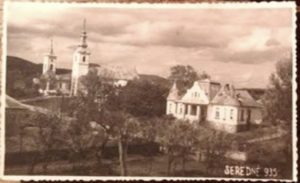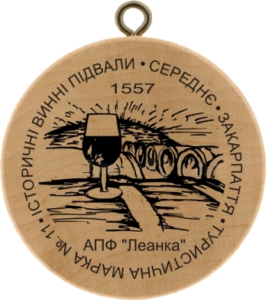Szerednye

The castle of Szerednye (Середнє) is located in Subcarpathian Region, in Ukraine. It has a special place among the Hungarian castles of this area, as it belongs to those medieval forts built on flatlands that still recognizably preserve their shape. The castle was built at the entrance of the valley: we must note that there were only very few stone castles in the Kingdom of Hungary before the Mongolian Invasion of 1241.

The town of Szerednye can be found halfway between Ungvár and Munkács, and it is supposed that its name is derived from the Slavic word „середина”, meaning “between”. Now, there are about 4,300 inhabitants in it, and one-third of them are still indigenous ethnic Hungarians.

The ruined castle is on the southwestern part of the settlement, on a small hill. Just follow the road along the stream behind the mill, and you will get there. The castle was built in the 12th century by the Templars. The Templars were mentioned first in Hungary in 1169, they were invited here from France by King Géza II. The Templars had properties in Bélavár (Kőrös County) and in Esztergom, too. Later, most of their domains were given to the Hospitaller Knights but Szedernye was given to the Paulinian monks of the Abbey of Jánk, Szatmár County. The castle was first mentioned in 1417 as “Zerednye”.

After them, Szerednye castle and its villages were owned by the Pálóczi family, the owner of Ungvár castle. According to a legend, Szedernye castle was connected to Ungvár castle by a secret underground tunnel. We know that the development of the settlement of Szedernye suffered much because of the peasant uprising of Dózsa György in 1514.

Pálóczi Antal, the last member of the family fell in the Battle of Mohács in 1526. The Dobó family was closely related to the Pálóczi family so they inherited their domains at Pálóc and Szedernye. However, it was Perényi Péter, the Guardian of the Hungarian Crown who was able to gain their largest property, it was Sárospatak castle. Perényi was the second wealthiest man after Szapolyai János and it could be interesting to learn more about him:
https://www.hungarianottomanwars.com/essays/lord-perenyi-peter-1502-1548-part-one/
The Dobó family completed the building of Szedernye castle’s defenses according to the rapid development of artillery. They produced lots of wine which made them very rich. It was the period when they forced their Ottoman captives to build wine cellars under the castle. These cellars are still in use. One of the most famous owners of Szedernye castle was Captain Dobó István who heroically defended Eger castle against the enemy in 1552.

Captain Dobó received more castles and domains from King Ferdinand and we know that he loved Szedernye castle. He has used to stay there several times and enjoyed hunting in the area. When he died in 1572, his body was buried in the village of Dobóruszka but his heart was placed to rest in Szedernye castle. After his death, the Drugeth of Homonna family gained control over Szedernye castle, and they inherited almost half of Ung County as well.

Later, Szedernye castle was owned by the Rákóczi family in the 17th century. The small fort had been functioning until the 18th century, it had an important role in controlling the trade route between Ungvár and Lemberg (Lviv) which was located in Poland. The Subcarpathian Region was the area where the War of Independence of Prince Rákóczi II Ferenc broke out, and during the war (1703-1711) the inhabitants of Szedernye took an active part in supporting Rákóczi. When the freedom fight was put down, the Imperial troops took their revenge both on the castle of Szedernye and its town. The castle was destroyed and it has never been rebuilt ever since.

The Perényi and the Barkóczy families inherited Szedernye castle but they did not spend money on renovating it. Later, a fire caused further damage. By the first part of the 19th century, the castle was in ruins. The old castle had a central tower, standing on an 18,5X18,5 m foundation. The tower had at least three floors and it had no entrance on the ground floor, only on the first floor. It means a detachable wooden structure of stairs was connected to the gate. There were dungeons and a wine cellar under the tower, the knightly hall was located on the first floor, along with a few smaller rooms. The landlord’s dwelling hall was above them.

The walls of the castle were 2,65 meters wide, and a few remaining walls were 12 meters high. Now, we can see only parts of the first level, the carved stones had been carried away by the local inhabitants, and it seems to have been the fate of every castle. The stones of the castle continue their lives in the houses of the settlement. The castle used to be surrounded by a wide but not very deep moat, and there was a second moat around it where the water of the stream was flowing. The length of the outer trenches is 195X195 meters.

Egán Ede, the Hungarian agronomist, and culture-politician (coming from a princely Irish family) was murdered at Szedernye in 1901. Egán devoted his life to helping the lives of the impoverished Ruthenian and Hungarian people of the region. He is regarded as the “father of the Ruthenian people” because he had done a lot for the economic improvement of the area. The Ruthenians erected a memorial cross to him at Börvinges, 10 kilometers from Szedernye. Szedernye was occupied by Czech troops after 1918, then it was again part of Hungary between 1939 and 1944. After this, the Soviets owned the area, and it became part of Ukraine in 1991.

Dear Readers, I can only make this content available through small donations or by selling my books or T-shirts.
If you like my writings, please feel free to support me with a coffee here:
You can check out my books on Amazon or Draft2Digital, they are available in hardcover, paperback, or ebook:
https://www.amazon.com/dp/198020490X or at https://books2read.com/b/boYd81

My work can also be followed and supported on Patreon: Become a Patron!http://Become a Patron!
















